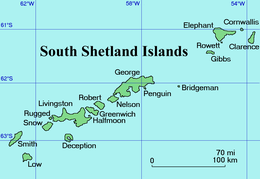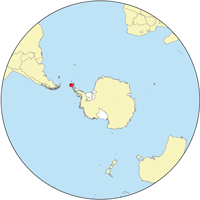South Shetlands

Map of the South Shetland Islands.
|
|

Location of the South Shetlands.
|
|
| Geography | |
|---|---|
| Location | Antarctica |
| Coordinates | 62°0′S 58°0′W / 62.000°S 58.000°W |
| Area | 3,687 km2 (1,424 sq mi) |
| Highest elevation | 2,300 m (7,500 ft) |
| Highest point | Mount Irving |
| Administration | |
|
None
|
|
| Demographics | |
| Population | around 500 |
| Additional information | |
| Administered under the Antarctic Treaty System | |
The South Shetland Islands are a group of Antarctic islands, lying about 120 kilometres (75 mi) north of the Antarctic Peninsula, with a total area of 3,687 square kilometres (1,424 sq mi). By the Antarctic Treaty of 1959, the islands' sovereignty is neither recognized nor disputed by the signatories and they are free for use by any signatory for non-military purposes.
The islands have been claimed by the United Kingdom since 1908 and have been part of the British Antarctic Territory since 1962. They are also claimed by the governments of Chile (since 1940, as part of the Antártica Chilena province) and by Argentina (since 1943, as part of Argentine Antarctica, Tierra del Fuego Province).
Several countries maintain research stations on the islands. Most of them are situated on King George Island, benefitting from the airfield of the Chilean base Eduardo Frei.
There are sixteen research stations to date in different parts of the islands, with Chilean stations being the greatest in number. Research is often a shared duty of nations, with the Chilean-United States Shirreff Base being one example.
Chilean scientists have claimed that Amerind visited the islands, due to stone artifacts recovered from bottom-sampling operations in Admiralty Bay, King George Island and Discovery Bay, Greenwich Island; however, the artifacts — two arrowheads — were later found to have been planted. The Dutchman Dirck Gerritsz in 1599, or the Spaniard Gabriel de Castilla in 1603, supposedly sailed south of the Drake Passage in the South Shetland Islands area. In 1818 Juan Pedro de Aguirre obtained permission from the Buenos Aires authorities to establish a base for sealing on "some of the uninhabited islands near the South Pole".
...
Wikipedia
